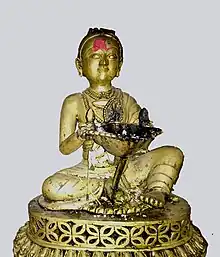Briddhi Lakshmi
Briddhi Lakshmi (Nepal Bhasa: 𑐰𑐺𑐡𑑂𑐢𑐶𑐮𑐎𑑂𑐲𑑂𑐩𑐷) was the queen consort of the Kingdom of Bhaktapur (modern day Bhaktapur), the first wife of Ranajit Malla and a well renowned Newar language poet.[1] For a brief period, she was also the monarch of an independent Thimi and Banepa.[2] She is today mostly remembered for the songs and poems she composed, some of which are still sung today by traditional Dapha groups in Thimi.[3]
| Briddhi Lakshmi | |
|---|---|
 Possible gold plated bronze image of Briddhi Lakshmi | |
| Queen Consort of Bhaktapur | |
| Predecessor | Vishva Lakshmi |
| Successor | Position abolished |
| Queen of Thimi and Banepa | |
| Tenure | c.1740 — c.1742 |
| Predecessor | Position establsihed |
| Successor | Position abolished |
| Born | Unknown Bettiah, Present day India |
| Died | Unknown Bhaktapur Durbar Square, Kingdom of Bhaktapur (Present day Bhaktapur, Nepal) |
| Spouse | Ranajit Malla (m. 1712) |
| Issue | Devendra Malla |
| Religion | Hinduism |
She was born in a noble family in Bettiah, in modern-day India and had a brother named Murāri Rāya.[4] In 1712, an envoy was sent from Bhaktapur to fetch her to the kingdom and marry her to then crown prince Ranajit Malla. Although, she was extremely well loved by the populace of the kingdom, she found herself more isolated in the palace. After failing to provide a male heir, she found herself replaced by Jaya Lakshmi, a favorite concubine of Ranajit Malla. By the time she gave birth to Devendra Malla, Jaya Lakshmi's eldest son had already reached maturity.[5] The people in the kingdom wanted her newborn to be the crown prince, since she was the queen consort, however Jaya Lakshmi who held significant power in the palace was against this idea and so she found herself in precarious situation.[2] After her followers in the palace were assassinated one by one, she fled to Thimi with her infant son and the populace of Thimi soon after her arrival declared Thimi as an independent state from the Kingdom of Bhaktapur with Briddhi Lakshmi as their queen.[2]
She was a prolific poet and songwriter in the Newar language.[3] Only six of her works survive today, however, preserved by traditional singing groups in Thimi.[3] Her poem, "𑐎 𑐏 𑐫𑐵 𑐩𑑂𑐫𑐾" (ka kha yā mye), which she composed when her and her infant's safety was compromised in the palace, is considered one of the greatest works in the Newar language.[3]
Early life
On November 1711, an envoy led by Bhairava Malla and Vira Joshi was dispatched by Bhupatindra Malla to Bettiah in order to fetch Briddhi Lakshmi to Bhaktapur.[6] The expenditure book of their journey is so far the only source about Briddhi Lakshmi's early life. The expenditure book does not mention her name and refers to her as "kanyā", a term used for an unmarried girl.[7] However, the book does mention her brother's name, Murāri Rāya.[8] Bridhhi Laksmhi, as per the book was not of a royal descent.[7]
By February 1722, the envoy had returned to Bhaktapur with Briddhi Lakshmi and her brother, Murāri Rāya, who had accompanied his sister but returned after they arrived safely in Bhaktapur.[9] Briddhi Lakshmi was married to the crown prince Ranajit Malla eight months after her arrival, on the first day of kartika vadi 833 NS (October–November 1712).[8]
Flight to Thimi
Background
Ranajit Malla who ascended the throne after his father's death in May of 1722 had many concubines and one particular concubine, Jaya Lakshmi soon became a favorite of the king.[10] Jayalaskhmi gave birth to a prince, Ajitasimha Malla, who as per a religious document from 1728 had been declared as the crown prince.[10] Ten years later, on June 1738, Briddhi Lakshmi gave birth to a prince in Thimi.[2] Because Briddhi Lakshmi was Ranajit Malla's only legal wife, the people of his kingdom and his chief minister supported her son and upon their advice Ranajit Malla declared Briddhi Laskhmi's son as the crown prince which prompted Ajitasimha Malla and his mother Jayalakshmi to start a mutiny in the palace.[10] Meanwhile, Briddhi Lakshmi set up a copper plate inscription at a temple in Bhaktapur to commemorate this event which is the oldest document that contains Briddhi Lakshmi's name and which mentions her son's name as Vira Narasimha Malla.[10]
Jayalakshmi and her son continued their mutiny in the palace, demanding the reappoint Ajitasimha Malla as the crown prince. As a result of her being the king's favorite, she was supported by almost everyone in the palace and using her power one by one assassinated the few supporters Briddhi Lakshmi had in the palace.[10] Father Cassino, a Capuchin missionary who had been staying in Bhaktapur during this crisis wrote on his journal, "The queen (Briddhi Lakshmi) could not stay in peace in a place where her enemy (Jayalakshmi) held all the power".[2] Two poems written by Briddhi Lakshmi describes her experience during this crisis.[10]
References
Citations
- Tuladhar, Prem Shanti (2000). Nepal Bhasa Sahitya ya Itihasa (in Newari). Nepal Bhasa Academy. p. 54.
- Regmi, DR (2007). Medieval Nepal Part II. New Delhi, India: Rupa and Co. pp. 246–248. ISBN 978-8129110985.
- Tuladhar, Prem Shanti (2000). Nepal Bhasa Sahitya ya Itihasa (in Newari). Nepal Bhasa Academy. p. 54.
- Bajrācārya 1989, p. 1.
- Dhaubhadel 2020, p. 32.
- Bajrācārya 1989, p. 9.
- Bajrācārya 1989, p. 6.
- Bajrācārya 1989, p. 7.
- Bajrācārya 1989, p. 4.
- Dhaubhadel 2020, p. 33.
Bilbiography
- Bajrācārya, Cundā (1989). Raṇajīta Mallayā ihipāyāta bhamca kāḥvaṅguyā-dharaḥpau (in Newari). Rāmabhakta Bhommi.
- Dhaubhadel, Om Prasad (September 2020). "Ranajita Malla ra satbahale rajkumara haru" (PDF). Bhaktapur (in Nepali). Vol. 286. Bhaktapur Municipality. pp. 33–38.